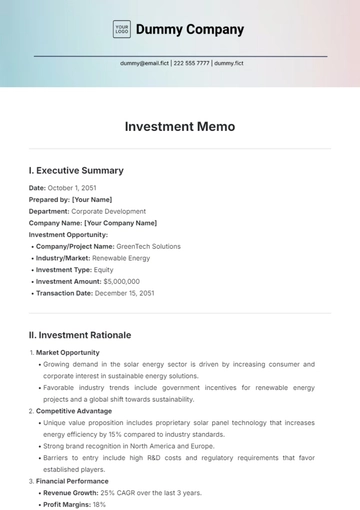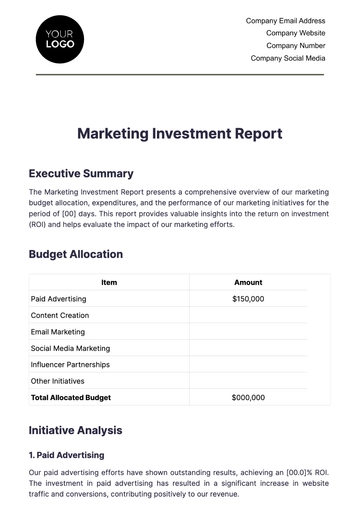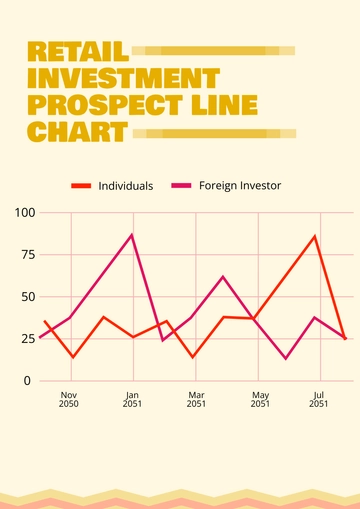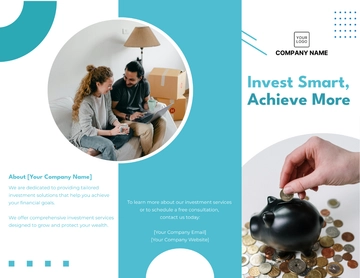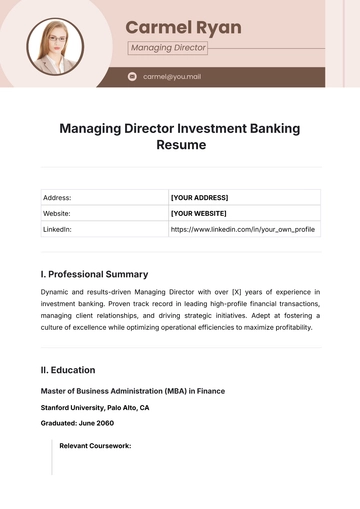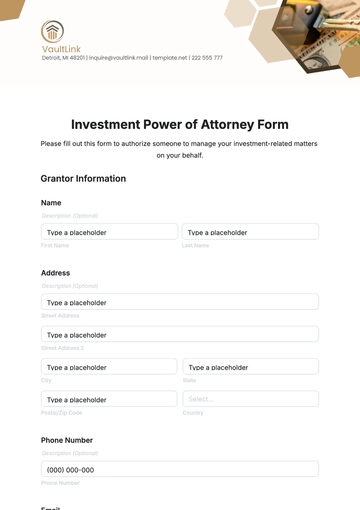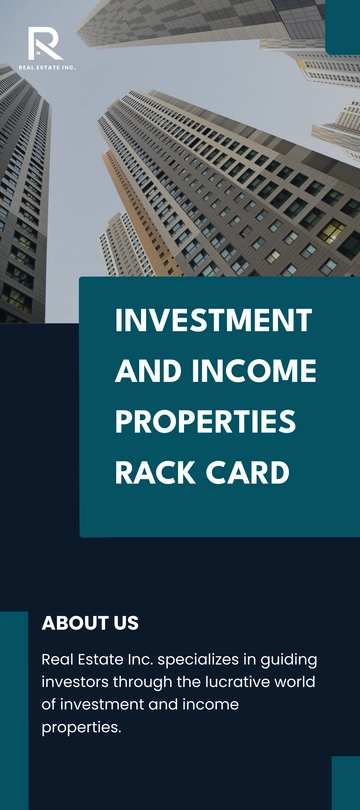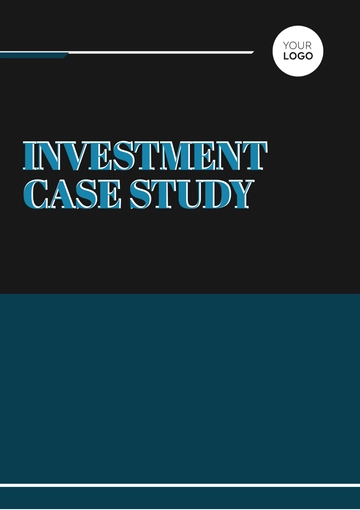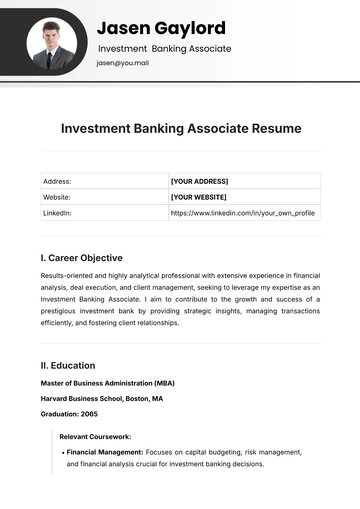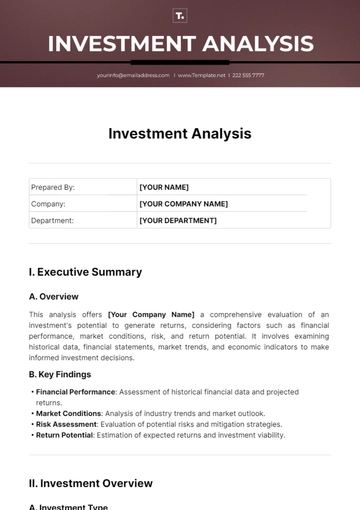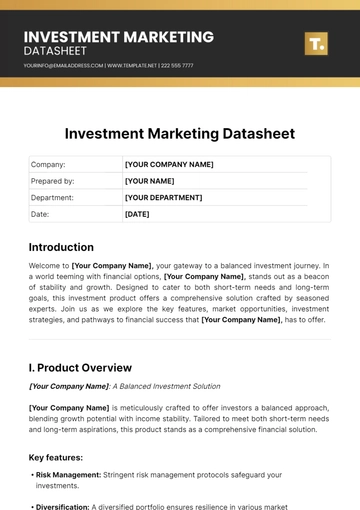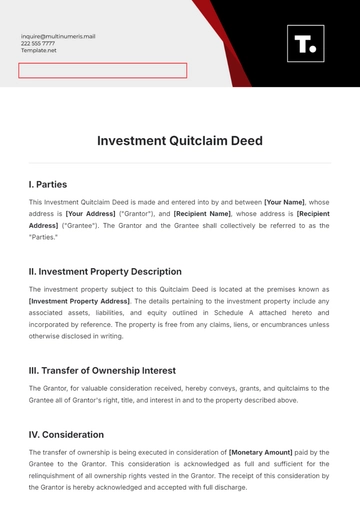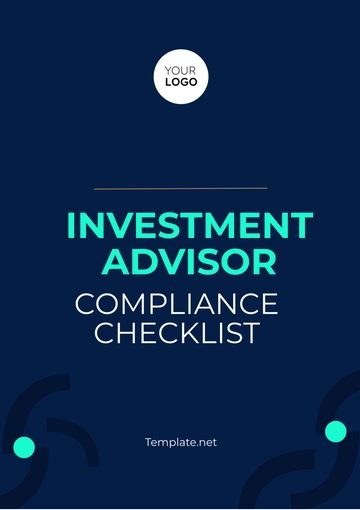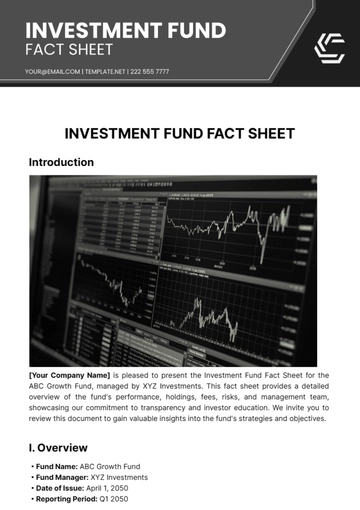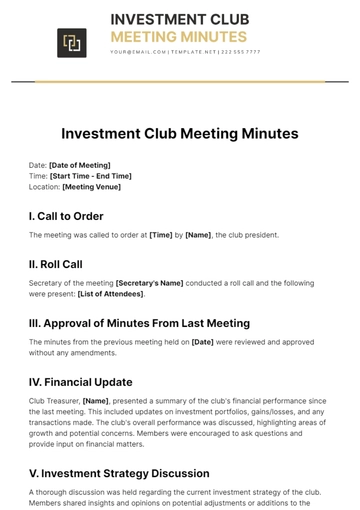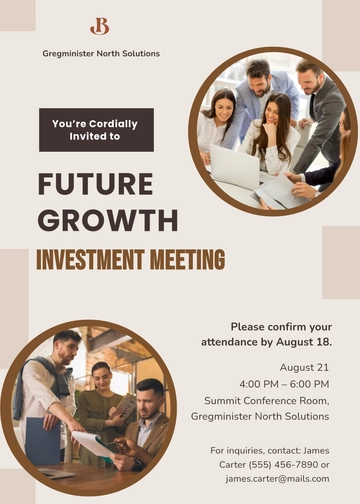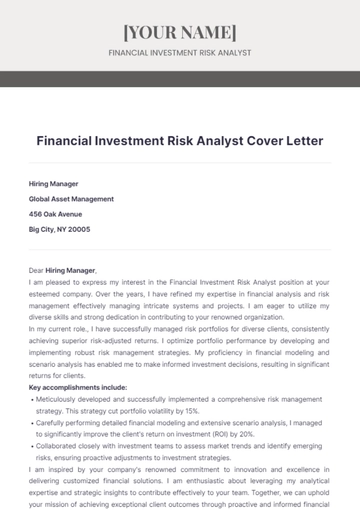Free Financial Investment Case Study
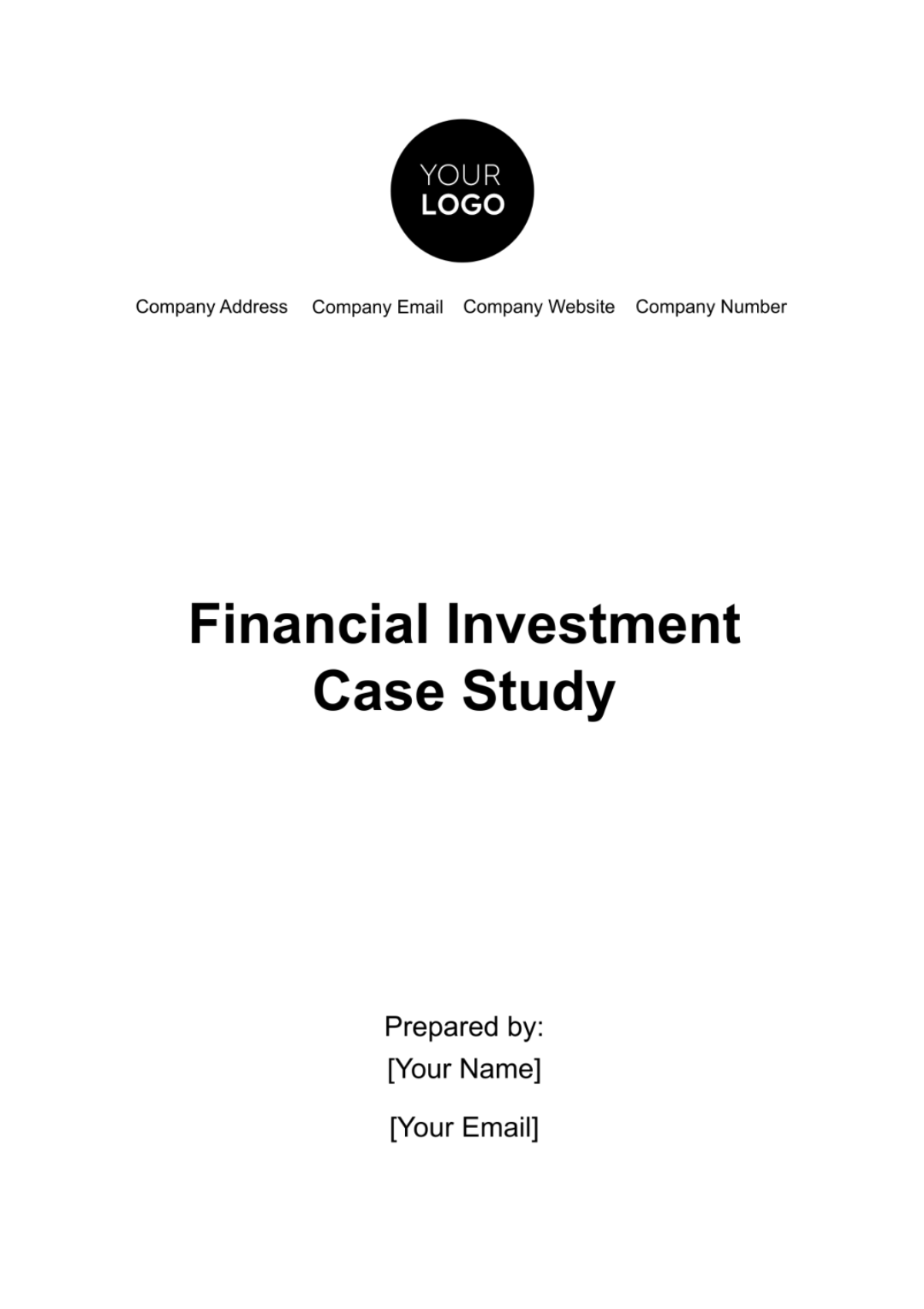
I. Introduction
At the crossroads of financial growth and technological advancement, our organization embarked on a strategic investment journey with the establishment of a cutting-edge Artificial Intelligence (AI) startup. This study peels back the layers of our decision-making process, offering an in-depth exploration of our objectives, the challenges encountered, and the lessons learned throughout our tech investment journey. Navigating the dynamic landscape of the tech sector, our commitment to financial prudence and staying at the forefront of industry trends becomes evident in each strategic choice we make.
II. Background
A. Market Trends
Our decision to invest in the AI startup was rooted in a meticulous analysis of market trends. We closely examined emerging technologies, market demand, and the competitive dynamics shaping the decision to venture in the AI space.
B. Regulatory Frameworks and Compliance
We conducted a detailed examination of local and international regulations to ensure compliance and to anticipate any potential changes that could impact our investment in the tech startup. By understanding and adhering to regulatory requirements, we aimed to mitigate risks and foster a stable operational environment.
C. Technological Advancements and Innovation
Staying at the forefront of technological advancements was a key consideration. Our investment background involved a deep exploration of innovative technologies in the AI domain. We assessed the startup's technological roadmap, ensuring that our investment aligned with the latest industry advancements and could leverage cutting-edge innovations.
D. Competitive Landscape Assessment
A meticulous assessment of the competitive landscape was integral to our decision-making. By understanding the strengths and weaknesses of existing players in the tech sector, we strategically positioned our investment for success within the broader industry context. This involved analyzing market share, unique value propositions, and potential areas for collaboration or differentiation.
III. Investment Objectives
A. Financial Growth and Returns
One of our primary objectives was to achieve compelling financial growth and returns. We aimed to capitalize on the innovative solutions offered by the AI startup to generate sustainable revenue streams.
B. Technological Leadership and Innovation
A key objective was to establish technological leadership and foster innovation. By investing in an AI startup at the forefront of technological advancements, we aimed to position ourselves as leaders in the tech sector.
C. Strategic Industry Positioning
Strategic industry positioning was another critical objective. Our investment aimed to strategically position our organization within the competitive tech landscape. This involved leveraging the capabilities of the AI startup to carve out a distinct niche, enhancing our visibility and influence within the broader industry.
IV. Investment Decision Process
A. Preliminary Screening
In the initial phase of our investment decision process, we conducted a preliminary screening to identify potential opportunities in the tech sector. This involved evaluating various market segments, technologies, and emerging trends. Our aim was to filter out investments that did not align with our strategic objectives and focus on those with the greatest potential for success.
B. Opportunity Assessment
Once potential investment opportunities were identified, we engaged in a comprehensive opportunity assessment. This phase involved a detailed evaluation of the AI startup, considering factors such as its business model, technology stack, leadership team, and market positioning. This step allowed us to gauge the viability and attractiveness of the investment.
C. Due Diligence
With promising opportunities on the horizon, we proceeded to the due diligence phase. This involved an exhaustive examination of the AI startup's financial health, legal standing, intellectual property, and potential risks. Our due diligence process aimed to uncover any hidden challenges and ensure a thorough understanding of the startup's operational and financial landscape.
D. Financial Modeling and Projections
Upon successful due diligence, we engaged in financial modeling and projections. This phase involved creating detailed financial models to assess the potential returns and risks associated with the investment. We considered various scenarios and stress-tested our assumptions to develop a robust understanding of the financial implications.
E. Risk Analysis and Mitigation Strategies
A crucial aspect of our investment decision process was the identification and analysis of risks. We meticulously examined market risks, technology risks, and operational risks associated with the AI startup. Subsequently, we developed comprehensive mitigation strategies to address and minimize these risks, ensuring a proactive approach to risk management.
F. Investment Committee Review
Before finalizing the investment decision, we presented our findings and recommendations to the investment committee. This cross-functional team, consisting of key decision-makers, critically assessed the proposed investment based on the opportunity assessment, due diligence results, financial models, and risk analysis. The committee's input played a pivotal role in shaping the final decision.
G. Decision Approval and Execution
Following a thorough review by the investment committee, the final decision was made. This involved securing the necessary approvals and executing the investment agreement. The decision-making process concluded with a strategic plan for the integration of the AI startup into our portfolio, outlining key milestones, performance metrics, and ongoing monitoring mechanisms.
V. Financial Analysis
The table below presents a snapshot of the financial analysis, showcasing key metrics and performance indicators derived from our in-depth assessment:
Metric | [Year 1] | [Year 2] | [Year 3] | [Year 4] |
Revenue | $2,500,000 | $3,200,000 | $4,000,000 | $6,500,000 |
Net Profit Margin | ||||
Return on Investment | ||||
Cash Flow |
The financial analysis not only signifies the current fiscal robustness but paints a picture of anticipated growth. Revenue projections showcase a steady increase, emphasizing the startup's efficiency and profitability over the projected period. The upward trajectory of these metrics reaffirms our confidence in the investment, demonstrating its potential to not only sustain but thrive in the competitive tech market.
VI. Market Analysis
A. Industry Landscape
Our market analysis delved into the broader industry landscape, examining factors that influenced our investment decision. This involved scrutinizing market size, growth rates, and identifying key players. The AI startup's positioning within this landscape was pivotal in understanding its potential impact and growth opportunities.
B. Emerging Trends
Identifying and understanding emerging trends within the tech and AI sector was a crucial aspect of our market analysis. We explored advancements in AI technology, changing consumer behaviors, and market demands. This foresight allowed us to align our investment with evolving market needs, ensuring the startup's relevance and potential for sustained growth.
C. Competitive Analysis
A comprehensive competitive analysis was conducted to assess the AI startup's unique value proposition and differentiators. We examined competitors' strengths and weaknesses, market share dynamics, and potential areas for collaboration or disruption. This analysis informed our decision-making, ensuring our investment was strategically positioned within the competitive landscape.
D. Regulatory Environment
Market conditions are closely tied to regulatory environments. We assessed the regulatory landscape governing the tech and AI industry, anticipating potential challenges and ensuring compliance. This proactive approach minimized regulatory risks and contributed to a smoother implementation of our investment strategy.
VII. Implementation
A. Strategic Planning
The execution of our investment decision involved meticulous strategic planning. We developed a comprehensive roadmap outlining key milestones, timelines, and performance metrics. This strategic plan served as a guiding framework, ensuring a cohesive and organized approach to the implementation phase.
B. Team Alignment and Resources
Successful execution required alignment within our internal team and allocation of resources. We ensured that key stakeholders understood the strategic objectives, and resources were allocated efficiently. This alignment fostered a collaborative environment, enhancing the startup's integration into our portfolio.
C. Investment Agreement and Legal Formalities
The execution phase included finalizing the investment agreement and addressing legal formalities. This involved working closely with legal experts to ensure all contractual obligations were met, mitigating legal risks, and creating a foundation for a secure and compliant investment.
D. Monitoring and Optimization
Post-implementation, a robust monitoring and optimization framework was established. Key performance indicators were tracked, and adjustments were made to optimize outcomes. This iterative process ensured that our investment remained aligned with market dynamics and continued to deliver positive results.
E. Stakeholder Communication
Transparent communication with stakeholders was integral throughout the implementation phase. Regular updates and clear communication channels were maintained, fostering trust and understanding. This approach facilitated a collaborative environment, aligning all parties toward common goals.
VIII. Performance Evaluation
A. Comparison to Objectives
The performance evaluation involved a meticulous comparison of the AI startup's actual performance against our initial objectives. Key performance indicators (KPIs) were scrutinized, focusing on areas such as revenue growth, market share, and profitability. The observed outcomes indicated a commendable alignment with our predefined objectives, showcasing the startup's ability to meet and, in some instances, surpass expectations.
B. Market Impact and Positioning
Assessing the market impact and positioning of the AI startup was crucial in determining its overall performance. The startup not only gained a foothold in the competitive landscape but also contributed to market trends. Its innovative solutions addressed emerging needs, reflecting positively on its market impact and establishing a strong position within the industry.
C. Return on Investment (ROI)
The observed ROI surpassed initial projections, indicating a lucrative outcome. The startup's financial health and sustained growth contributed to a favorable ROI, validating the soundness of our investment decision and its positive impact on our overall portfolio.
IX. Risks and Challenges
A. Risk Identification
Throughout the investment lifecycle, proactive risk identification was a foundational element. We systematically identified potential risks associated with the AI startup investment, considering market fluctuations, technological disruptions, and regulatory changes. This meticulous approach allowed us to develop a robust risk management strategy.
B. Mitigation Strategies
Having identified risks, we have implemented effective mitigation strategies. These strategies were tailored to address specific challenges, ensuring a proactive response to potential setbacks. By diversifying risk mitigation approaches, including financial hedging and strategic partnerships, we minimized the impact of identified risks on the investment.
C. Adaptive Decision-Making
As unforeseen challenges emerged, we leveraged our organizational agility to make timely adjustments. This adaptive approach ensured that the investment strategy remained resilient in the face of dynamic market conditions.
D. Continuous Monitoring and Iteration
Continuous monitoring of risks and challenges was integrated into our investment management approach. Regular reviews allowed us to identify evolving risks and address them iteratively. This dynamic process of monitoring and iteration ensured that our risk management strategies remained effective, contributing to the sustained success of the investment.
X. Lessons Learned
A. Strategic Alignment
One of the pivotal lessons learned from our investment in the AI startup was the importance of strategic alignment. Ensuring that the investment aligns closely with the overarching strategic goals of our organization is crucial.
B. Agile Decision-Making
The dynamic nature of the tech industry emphasized the value of agile decision-making. Rapid changes in market conditions and emerging trends required us to adapt quickly. The ability to make agile decisions, backed by real-time data and insights, emerged as a key factor in navigating uncertainties and maximizing opportunities.
C. Robust Risk Management
Our experience reinforced the significance of robust risk management practices. Identifying, analyzing, and mitigating risks early in the investment lifecycle proved instrumental.
D. Continuous Monitoring and Adaptation
Continuous monitoring and adaptation were identified as critical components of successful investment management. The investment landscape evolves, and a proactive approach to monitoring performance, market conditions, and risk indicators allows for timely adaptations.
E. Stakeholder Communication
Transparent and open communication fostered trust and alignment. Keeping stakeholders informed about the progress, challenges, and successes of the investment built a collaborative atmosphere, contributing to a shared understanding of the investment's trajectory.
F. Talent and Leadership
The role of talent and leadership in driving successful investments became evident. The startup's leadership team and its talent pool played a pivotal role in the investment's success.
G. Innovation and Adaptability
Innovation and adaptability were identified as key drivers of success in the ever-evolving tech landscape. The ability to innovate and adapt to changing market dynamics allowed the AI startup to maintain a competitive edge.
XI. Recommendations
A. Strategic Portfolio Diversification
Building on the success of the AI startup investment, we recommend a continued focus on strategic portfolio diversification. Identifying and exploring emerging sectors with growth potential will further enhance the resilience of our investment portfolio. This approach aligns with our commitment to mitigating risks and capturing new opportunities in dynamic markets.
B. Embrace Technological Advancements
In light of the AI startup's success, we strongly recommend a proactive stance toward embracing technological advancements. Keeping abreast of emerging technologies and trends ensures that our portfolio remains at the forefront of innovation. This forward-looking approach positions us to capitalize on transformative technologies that can shape the future landscape of the industries we operate in.
C. Strengthen Risk Management Practices
We recommend continuous refinement and strengthening of our risk management framework. This includes a comprehensive review of risk identification processes, adaptive risk mitigation strategies, and the incorporation of predictive analytics to anticipate and address potential challenges.
D. Foster a Culture of Innovation
Encouraging a culture of innovation within our organization is paramount. The success of the AI startup highlighted the positive outcomes that result from fostering an environment that values creativity, experimentation, and forward-thinking. We recommend initiatives that nurture a culture where employees are empowered to contribute innovative ideas and explore new approaches to problem-solving.
E. Collaborate and Form Strategic Alliances
Building on the collaborative success of the AI startup, we recommend actively seeking opportunities for strategic alliances and collaborations. Partnering with complementary businesses, research institutions, or industry leaders can amplify our capabilities, accelerate growth, and open doors to new markets. Strategic collaborations enhance our competitive advantage and create synergies that drive collective success.
F. Invest in Talent Development
Talent emerged as a critical factor in the success of our investment. We recommend a continued focus on talent development initiatives. This includes attracting top-tier talent, providing ongoing training and skill enhancement programs, and fostering a workplace culture that encourages continuous learning. A highly skilled and motivated team remains a key asset in achieving and sustaining investment success.
G. Regular Portfolio Review and Optimization
To ensure our investment portfolio remains adaptive to market dynamics, we recommend implementing regular portfolio reviews and optimization exercises. This proactive approach involves assessing the performance of existing investments, identifying areas for improvement, and strategically reallocating resources to align with evolving market trends and organizational objectives.
H. Leverage Data Analytics for Informed Decision-Making
The use of data analytics played a crucial role in our investment success. We recommend further leveraging data analytics tools and technologies to inform decision-making across our investment lifecycle. This includes predictive analytics for market trends, data-driven risk assessments, and performance analytics to continually refine our investment strategies.
XII. Conclusion
In conclusion, our investment in the AI startup stands as a testament to the success that can be achieved through strategic decision-making and adaptability in the dynamic landscape of financial investments. The positive outcomes, including surpassing objectives and realizing a favorable return on investment, underscore the effectiveness of our approach. The case study highlights the importance of aligning investments with overarching organizational goals, fostering innovation, and maintaining open communication with stakeholders. Moreover, the valuable lessons learned, from the significance of agile decision-making to the critical role of talent and leadership, will shape our future investment strategies. As we reflect on this case study, we are propelled forward with a strengthened commitment to continued growth, resilience, and strategic excellence in our financial investments.
- 100% Customizable, free editor
- Access 1 Million+ Templates, photo’s & graphics
- Download or share as a template
- Click and replace photos, graphics, text, backgrounds
- Resize, crop, AI write & more
- Access advanced editor
Explore financial investments with the customizable Financial Investment Case Study Template from Template.net! This editable template transcends the ordinary, offering a dynamic format to showcase your investment journey. Craft a compelling case study, highlighting your successes with confidence and authority. Get it done easily using our intuitive AI Editor Tool!


